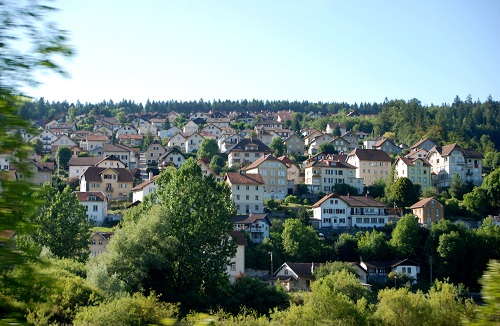
Assessing the GHG and energy impact of an urban planning project

The location of future constructions, the organisation of mobility, the design of urban forms, the definition of energy supply methods: all of this has an impact on a region's energy consumption and greenhouse gas (GHG) emissions.
The GES URBA online application is free and open to all. It was developed on the basis of the GES SCoT and GES PLU decision support tools, and is now available in a test version.
Designed to help local authorities be part of the process of reducing GHG emissions, it is used to assess urban planning projects by integrating numerous parameters that have an influence on greenhouse gas (GHG) emissions and energy consumption.
GES URBA explores the topics for which the town planning document possesses action levers: building rehabilitation and new construction standards, mobility, development of renewable energies and heating networks, urban renewal, land consumption and carbon storage, building use.
The application is aimed both at local authorities (areas of town planning and energy/climate in particular) and at town planning agencies or design offices. Users can build scenarios and modify various parameters to determine the impact in terms of GHG emissions and energy. The interface consists of a series of questions to which the user provides qualitative or quantitative answers.
 L’application en ligne GES URBA est gratuite et ouverte à tous. Elle a été testée par plusieurs structures dont les retours sont très positifs.
L’application en ligne GES URBA est gratuite et ouverte à tous. Elle a été testée par plusieurs structures dont les retours sont très positifs.
Construire une démarche collectivement
GES Urba permet de construire collectivement des scénarios transversaux d'aménagement et d'échanger lors de la réalisation des documents d'urbanisme.
Il intègre les thématiques des documents d’urbanisme : localisation des zones à développer dans l’armature urbaine, typologies et normes des constructions neuves, mobilité des personnes et des marchandises, développement des énergies renouvelables et des réseaux de chaleur, réhabilitation du bâti, impacts des changements d’occupation des sols... Il permet aussi d’évaluer l’articulation entre les SCoT, PLU ou PLUi et le PCAET.
L’outil GES Urba, gratuit et disponible en ligne, a été testé en 2021 par deux territoires et une agence d’urbanisme dans le cadre de SCoT et PLUi de territoires en croissance démographique. Il s’agissait de récolter leurs retours d’expérience notamment sur la prise en main de l’outil avec l'accompagnement du Cerema et sur la mobilisation des données nécessaires à son fonctionnement. Chaque utilisateur a fait des recommandations pour améliorer l’outil.
Selon ces premiers retours, une des forces de l’outil réside dans sa capacité à quantifier les impacts énergétiques et carbone des actions d’urbanisme à l’échelle d’un territoire. Le tout dans une approche transversale, alors que les politiques publiques sont souvent segmentées par secteurs.
Bien que "très ergonomique" d’après les premiers utilisateurs, il s’agit d’un outil assez technique qui présente des données et résultats exhaustifs, ce qui nécessite un certain bagage technique et un accompagnement pour être utilisé.
Enfin, GES Urba permet d’ajouter des données d’entrée au fil de l’avancement d’un projet et ainsi d’affiner les hypothèses. Les objectifs finaux peuvent être entrés dans l’application ultérieurement.
Evaluer l'impact GES et énergétique d'un projet d'urbanisme

La localisation des futures constructions, l’organisation des mobilités, la conception des formes urbaines, la définition des modes d’alimentation en énergie : tout cela a un impact sur les consommations d’énergie et les émissions de gaz à effet de serre (GES) d’un territoire.
Conçu pour aider les collectivités à s’inscrire dans la démarche de réduction des émissions de GES, GES Urba permet d’évaluer les projets d’urbanisme en prenant en compte de nombreux paramètres qui ont une influence sur les émissions de Gaz à effet de serre (GES) et les consommations d’énergie.
GES Urba explore les thématiques pour lesquelles le document d’urbanisme dispose de leviers d’action et s’adresse aussi bien aux collectivités (domaines de l’urbanisme et de l'énergie/climat notamment) qu’aux agences d’urbanisme ou aux bureaux d’études. Les utilisateurs peuvent construire des scénarios et modifier différents paramètres pour en déterminer l’impact en termes d’émissions de GES et d’énergie.
L’interface intègre un ensemble de questions auxquelles l’utilisateur apporte des réponses qualitatives ou quantitatives.
Suite aux retours des premiers utilisateurs, le Cerema réfléchit à la manière de faire connaître et de transmettre le plus efficacement possible la méthode d’utilisation de l’outil.
GES Urba constitue un outil précieux d’aide à la décision pour mettre en œuvre la loi Climat et résilience qui impose des objectifs de réduction de 40% des émissions de gaz à effet de serre d’ici 2040.
Discover the application:
A range of features to define your project
GES Urba offers several features, to facilitate the definition of strategic orientations:
-
Regional diagnostic elements including numerous topics to facilitate the development of a continuous scenario (consumption of housing, mobility of people, heating networks and renewable energies already present in the region, etc.)
-
Analysis at different scales (SCoT [regional integrated development plan], PLU [local urban development plan] and PLUi [inter-communal urban development plan]),
-
The ability to work at different scales: poles or entire region depending on the progress of the project and the desired finesse of the hypotheses,
-
Articulate several themes and have a global vision of the energy-climate issue,
-
Online support, particularly for data collection.
The application can be mobilised:
-
during preparation of the Planning and Sustainable Development Project (PADD) of the planning document,
-
during its translation into the other parts of the town planning document (Document of objectives and guidelines (DOO), planning and programming guidelines (OAP), regulations),
And serves to:
-
address the interactions between town planning, transport, development of renewable energies, heating networks and land use change,
-
illustrate the effects of urban planning action levers on energy and greenhouse gases (GHGs),
-
Build on these elements to deal with the impact of the project on energy/climate in the environmental assessment of the document;

Presentation brochure
Les outils GES Cerema et Ademe : fiche de synthèse


